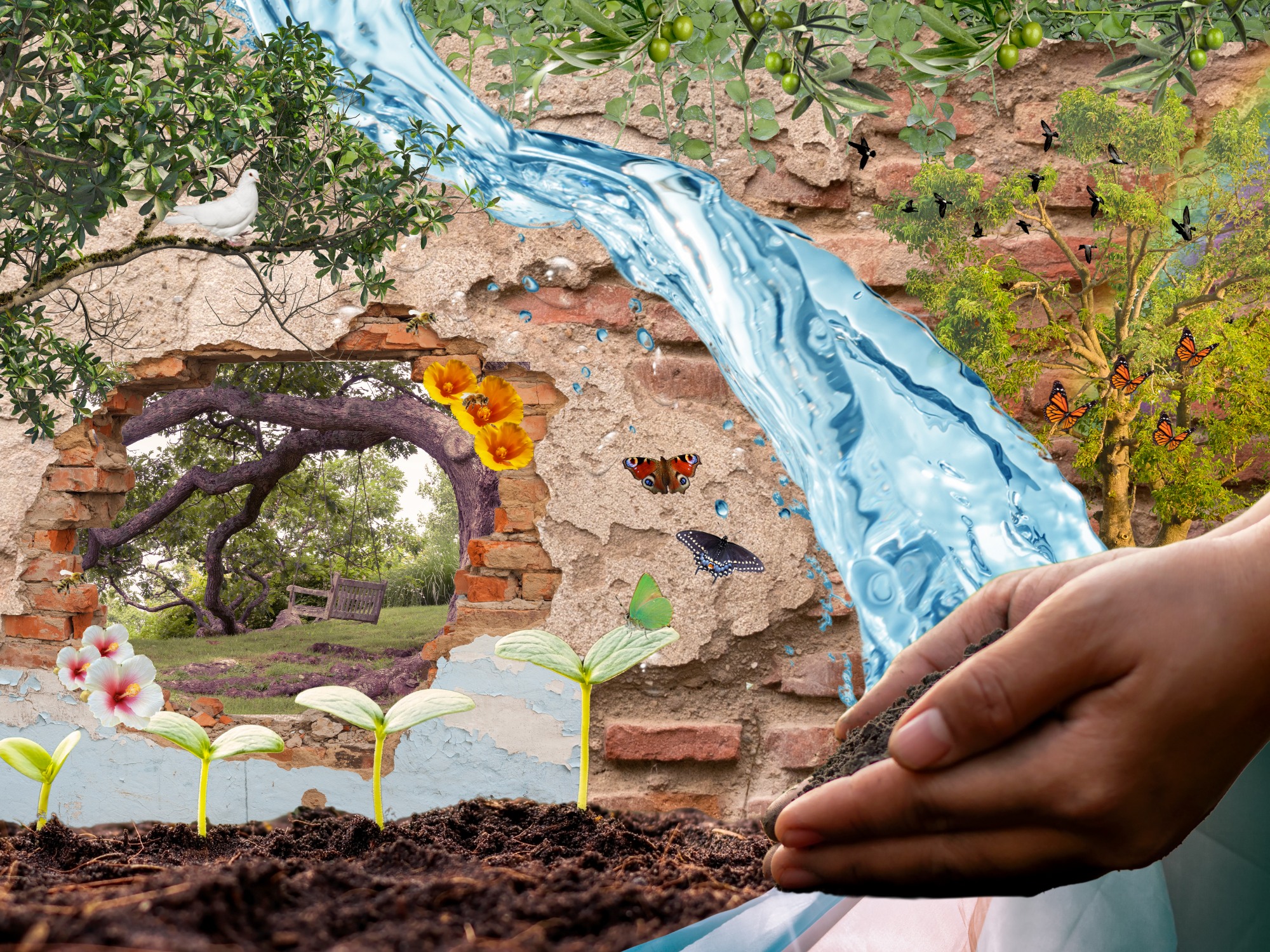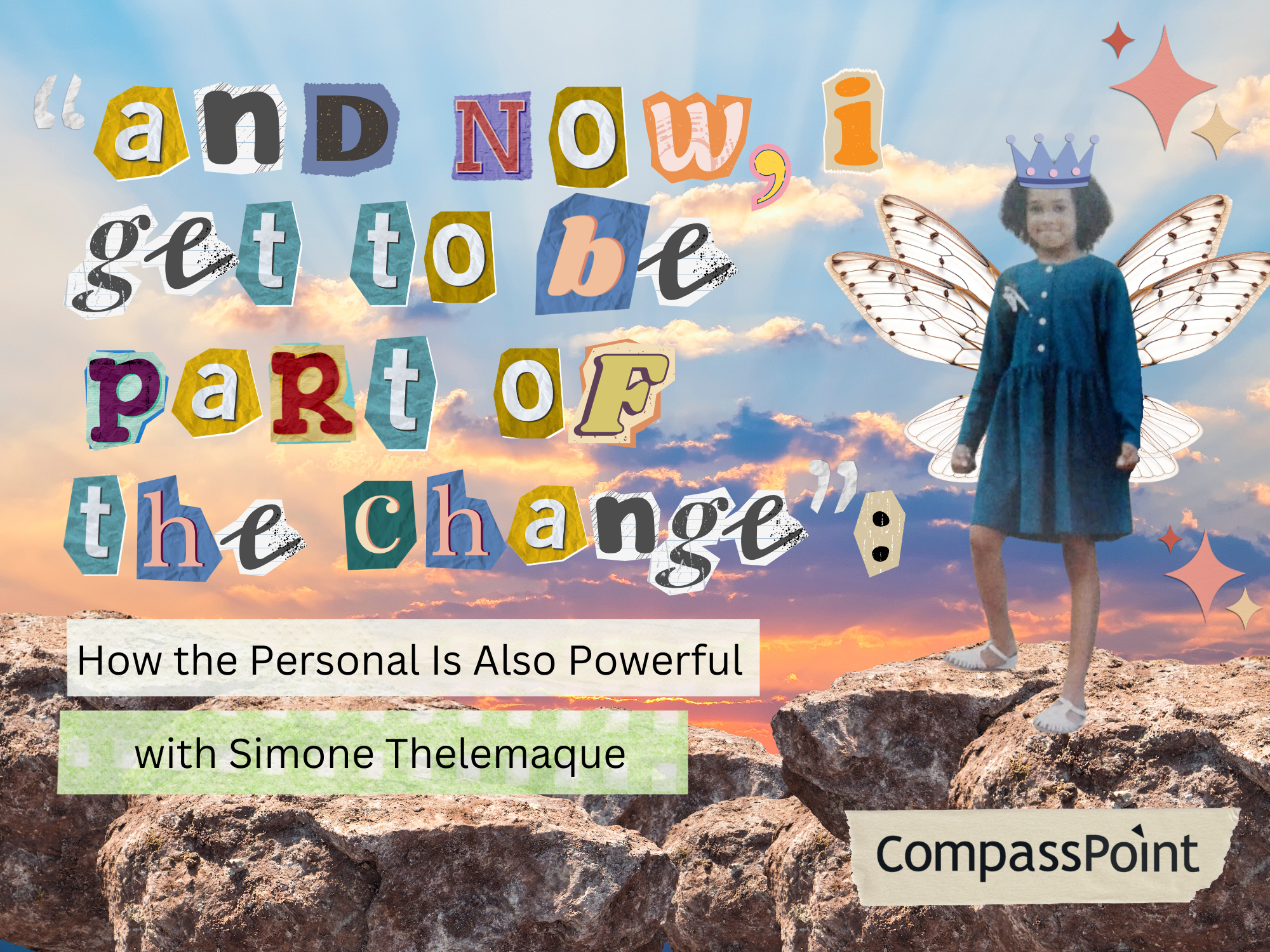Welcome back! We’re following up on the first blog in our series around our journey to center racial justice, equity, and a vision for leadership that centers liberation at CompassPoint. If you missed the first installment, catch up here. In this second part of our blog series, we’re talking about the power of visions.

I spend a lot of time in imaginary worlds and I bet you do to. From Wakanda, to Macondo, to the hallways of spaceships with Lilith and her brood, many of us have clocked a lot of time stepping through the looking glass into realms that bend reality as we know it. Even to the most self-described ‘creatively-deficient’ among us, there is a real hunger to step into new worlds with new rules.
At a time where we see and feel systemic breakdowns all around us, that power to imagine our way toward something different isn’t just a ‘strategic leadership asset’—it’s about survival.
We’ve written about the importance of embracing radical imagination and some more about how we landed on our new vision and values, but this time we wanted to share something else about the importance of visions: why we should build them together, and why visions need to start with truly seeing the present before before we look to the future.
The idea of the ‘visionary’ leader isn’t new. We can all agree on the importance of foresight in organizational, network, and movement leadership. But when we think of visionary leadership, it’s easy to default to the outdated idea of a solo, heroic leader looking into the future and returning with a roadmap for everyone else to follow. How much imagination and yearning for the future remains untapped when we work that way? Are we missing an opportunity to build a real common purpose?
Over the last three years at CompassPoint, I’ve realized that building a vision is also about something much more powerful—belonging. Having a common vision isn’t just about forecasting the future and being strategic, but about collaborating and creating forward momentum together. And powerful visions for the future have to start with a clear-sighted, honest look at where we are to begin with.
Seeing Where We Were
In the first blog of our series, we talked about the start our story of organizational change being 2016, when we named a collective ‘adaptive challenge’. Adaptive challenges are those that we often have not encountered before, and for which there’s often no known solution. They require us to grow and change, often in deep—and sometimes painful—ways.
Looking back on 2016, it’s clear that taking on naming an ‘adaptive challenge’ was ultimately about training our vision on ourselves to ask: Where are we as a community?
CompassPoint has a long history of being a resource to movement leaders; to leaders of color. So what was different about this time and this move toward change? What was pushing us toward deeper examination around what our role should be in challenging and transforming racist systems?
In the lead up to 2016, we had been feeling seismic shifts in the world: the truth about police brutality (known directly by Black and Brown communities for generations) crashing into newsfeeds and into national consciousness, the resurgence of white nationalism emboldened by political power across the country and the globe, the ratcheting up of environmental crises, mass shootings... But also: incredibly powerful movement building—waves of organizing to shift the narrative on immigration, #BlackLivesMatter showing us the power of decentralized networks in action, the largest gathering of indigenous tribes ever coming together at Standing Rock to stand up for native sovereignty and against environmental injustice...
By 2016, we had also experienced an influx of new team members, bringing with them new questions about how we approached our work (inside and out). At the same time, in our leadership programs, participants were pushing us to consider what kind of racial analysis we were bringing to our work. The world around us was changing and so was our internal culture. Individually, many of us were feeling a gap between where we were and where we wanted to be. We felt the agitation of change in our bones, but not a clear direction of what to do with that pent up energy.
Seeing the Heart of It
Visions are important when they cast their gaze toward the future, but they play an equally powerful role in shedding light into the nooks and crannies of seeing where we are now. Our ‘adaptive challenge’ project (led by sujin lee, Lupe Poblano, and Paola CubÍas) was a tool for seeing ourselves. It was a peer-led process, driven by an organizational commitment to really understand where we were at a moment defined by a feeling of uncertainty.
We focused on sharing our stories, and listening to each other.
Here are the questions we used in peer-to-peer interviews:
- What’s hard about this moment at CompassPoint?
- If you were 10x bolder, how would you really answer?
- What needs do you have that aren’t met? What are you longing for?
- How would you describe where we’re headed as an organization?
- What’s getting in the way?
The Seen and Unseen
What did we learn? First, that we were all eager to be heard—especially those with the least positional and social power and privilege. Secondly, we learned that people had deeply different understandings of the challenge of how we needed to change as a collective.
It’s helpful to think of an adaptive challenge like an iceberg. Above the waterline are the things that are seen and understood to everyone—our shared truths, conversations, agreements, and disagreements. At the tip of our iceberg, we were naming things like disagreements about how we dealt with positional power, how we could be clearer about roles, how we needed to embrace a culture of open feedback, what methods we should use in our programs, and how we should market our work.
Beneath the waterline, where the largest body of an iceberg lives, you’ll find unseen, unspoken truths. Here, we named themes that included faultines along differences of tenure and positional power, how we invisibilized some forms of work, our discomfort with power, our lack of real talk about what’s going on in the world and with each other, and our lack of clarity around a collective understanding of racism and structural oppression.
To sum up some of the themes,
the adaptive challenge team also created this poem:
We have many different perspectives
We hold multiple truthsWe live in different realities
Some are swimming underneath the water line, some are living on the surface
And there is a cost to all of us
And so our journeys toward liberation are not the same
And so much of it goes unspoken
And we have different understandings of how social change happens
And we need different things to feel whole
Are we at least looking in the same direction?
And our silence says so much.
What did that feel like in the moment? I can remember coming into work after the Pulse shooting in Orlando and feeling like there wasn’t a collective space to talk and grieve. Later that week, finding myself in community with other queer folks, I came together with friends and strangers, and we were led in a shared moment not of silence but of rage as we screamed into the rafters of our favorite bar. Was there a vision for a social justice organization like CompassPoint where there was room for that kind of anger to show up? What is the unspoken question about how much of our lives we’re supposed to leave checked at the door? I’ve seen the burden of that question fall heavily on women and people of color. On queer people and disabled folks. I think about my Black colleagues, too—especially Black women—and how often the emotional labor of keeping our community going ends up invisibilized in a dominant culture that prioritizes ‘productivity’ over relationships. “Our silence says so much...” Our culture wasn’t reflecting our best intentions for each other.
Seeing Together
It’s scary to surface these kinds of challenges. They’re deeply personal and get to the root of questions about equity and justice. They surface truths about how we’ve been harmed or how we’ve harmed others. And there’s no easy playbook or roadmap for these kids of challenges—which can feel paralyzing, especially for positional leaders. A community’s adaptive challenge—once named—has to be collectively grappled with to move forward.
The unifying theme of our own internal scan was that most of us shared an urgent and often painful common question: do I belong here? As a collective, we were starting to feel the outlines of a bigger challenge: a desire to name and dismantle white dominant culture in ourselves. We were realizing that we wanted a different way to be with each other that makes room for everyone’s life experience, gifts, and yearnings—even if we didn’t yet have a shared language or understanding around ‘habits of white supremacy’ and how these habits show up in workplace behaviors and culture.
To really see each other, we needed to build more of a shared language around structural oppression and racism—we need to make some space for healing, too. To really see each other we needed to make room to hear each other’s stories—to hear what our biggest aspirations were for ourselves, each other, and our communities and how we all saw ourselves contributing to a world where we all belonged (these Frames for Life Liberation and Belonging were one powerful tool we used and you can read about how we used them here.) We also realized we needed a forward- looking vision and values to be a new beacon calling us forward, and so we elected an internal Vision and Strategy team that worked to create our new vision and values from the ground up, codifying what was already yearning to come to the surface.
Working through a vision in this way has been non-linear, messy, creative, expansive, confusing, inspiring... and a whole host of other things. But ultimately, embracing emotional truths, lived experiences, and storytelling helped us surface deeper truths about what we see as our most personal connections to this work. It made space for everyone to see themselves in a vision for the future that we all have stake in because it includes all of us. And it invited us all to have agency and choice about how we want to contribute to that vision for equity and liberation inside of CompassPoint, with the people and organizations we work with, and beyond.
It’s allowed us to say, collectively, that we can’t abide by approaches to leading ourselves and others that don’t acknowledge the history, current reality, and consequences of racism; we can’t build organizations whose ultimate goal is achieving social justice on a foundation of oppression; and we can’t leave systems of white dominance and patriarchy intact if we are serious about building an equitable world.
What we can do is continue to show up to the ongoing work of unlearning the habits and practices that hold us back from our bigger vision for liberation. We can embrace conflict and disagreements as an essential part of this work. We can remind ourselves that each of us belong in this struggle and show in our actions that we need each other to win.
Read the other blogs in our series:
- Putting Racial Justice at the Heart: How Did CompassPoint Get Here?
- We Can't Work Toward Racial Justice and Equity Without Working on Relationships
Read More:
- Embracing Radical Imagination
- When Our Humanity Guides Our Strategies
- Planting Seeds for the Transformation of Our Workshops Program





Submit a comment
(2) Comments
TemTigue replied on Permalink
Hi, this is random, but where did you get the html template for this website? Thank you.
MaroG replied on Permalink
Hi there--
Our website was designed by Giant Rabbit: https://www.giantrabbit.com/